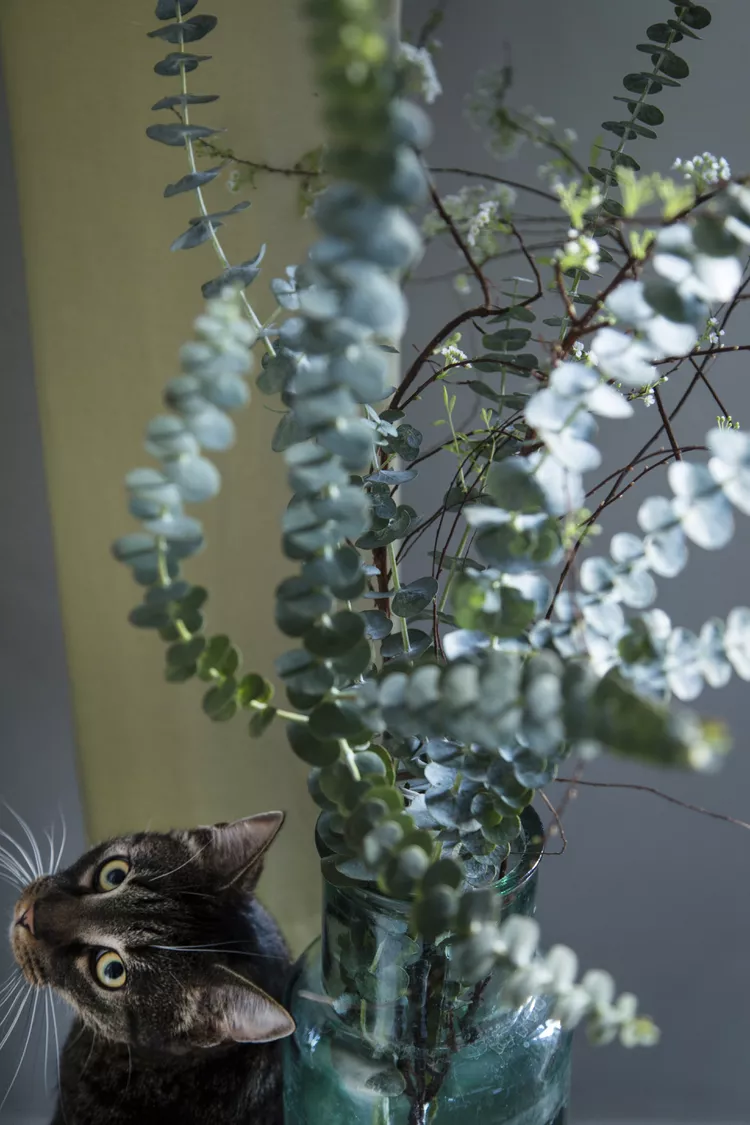Is Eucalyptus Safe for Cats?

Many people love the relaxing smell of dried eucalyptus or may have heard about the health benefits of eucalyptus essential oils. While it may be harmless enough for us, when it comes to our curious cats, eucalyptus is more complicated. As is often the case, products that may be perfectly safe for humans can pose risks to our sweet kitties, and we may need to reconsider how we use these products to keep our cats safe.
What Is Eucalyptus?
Eucalyptus plants are evergreens native to Australia and Tasmania and include many different species ranging in size from small leafy plants to large trees. Eucalyptus is popular for its relaxing and pleasant smell. Most often, dried leaves are used in floral arrangements for this purpose and many housewares, including candles and bath products, are scented with eucalyptus oil. Some health benefits of the plant have been touted, but there is no definitive scientific proof to back up these claims.
Is Eucalyptus Safe for Cats?
If you live with a kitty, you certainly know that they are very curious and have a tendency to get into the most unexpected places. Since there are so many forms of eucalyptus that may be found in our homes, determining the safety of these products for cats is very important.
In its pure form, the eucalyptus plant is considered toxic to cats if ingested. The most common physical signs of eucalyptus toxicity in cats would be vomiting, diarrhea, drooling, and/or lethargy. In most cases, they have to eat a large amount of the plant to get very sick but if you think your cat may have ingested any part of a eucalyptus plant, you should contact your veterinarian right away as well as a poison control hotline to determine the best course of treatment.
Eucalyptus Essential Oil
When dealing with eucalyptus essential oils, there are a few additional factors to consider. These oils are highly concentrated (with stronger effects than the actual plant) and considered toxic if eaten. They may also pose risks if they are inhaled or in contact with the fur and/or skin. It would take a concentrated high dose of eucalyptus essential oil to cause toxic effects directly through the skin or inhalation, but it is possible for the active ingredients to be absorbed through these routes. Also, cats are meticulous groomers, so you always have to assume that anything you put on your kitty’s fur or skin will be sampled with their tongues. For this reason, it is not recommended to use topical products containing eucalyptus on cats.
Warning
Because essential oils can irritate the lining of the respiratory passages and can be toxic to pets, it's best to avoid essential oil diffusers if you live with a feline friend.
When it comes to diffusing essential oils, there are a lot of safety concerns for pets. The main concern is that the oils themselves, or other ingredients in these products, could irritate the delicate lining of the respiratory passages and/or lungs and some ingredients could be toxic if inhaled. Some oils are known to be more irritating than others, and the purity of the oil can also affect its quality. For these reasons, the safest option is to avoid essential oil diffusers if you live with a feline friend, especially if your cat is already hypersensitive to certain odors or has a pre-existing condition like asthma that can make them especially sensitive to contaminants in the air.
What to Do If Your Cat Eats Eucalyptus
If your cat ingests a eucalyptus plant or product containing eucalyptus oil, your first step should be to contact your veterinarian as well as an animal poison control hotline such as the ASPCA Poison Control Hotline. Poison Control keeps careful records on all cases of toxicity and they often have the most up-to-date information regarding what to expect given a specific kind of toxin and the amount ingested. This will be helpful information for both you and your veterinarian so you can plan the best course of treatment.
Some cats will have mild tummy trouble like vomiting and/or diarrhea, which may be treated with supportive care. Some cats may have hypersensitivity and experience an allergic reaction with exposure that may result in respiratory or more serious clinical signs. More serious signs may require hospitalization, especially for cats with seizures, severe lethargy, or problems with their heart or blood pressure. For cats who are exposed to oils on their fur or skin, a thorough bath with a dish detergent like Dawn may be an important part of decontaminating them. This should be done in consultation with your veterinarian as it is not always safe to bathe a cat who is already experiencing signs of toxicity.